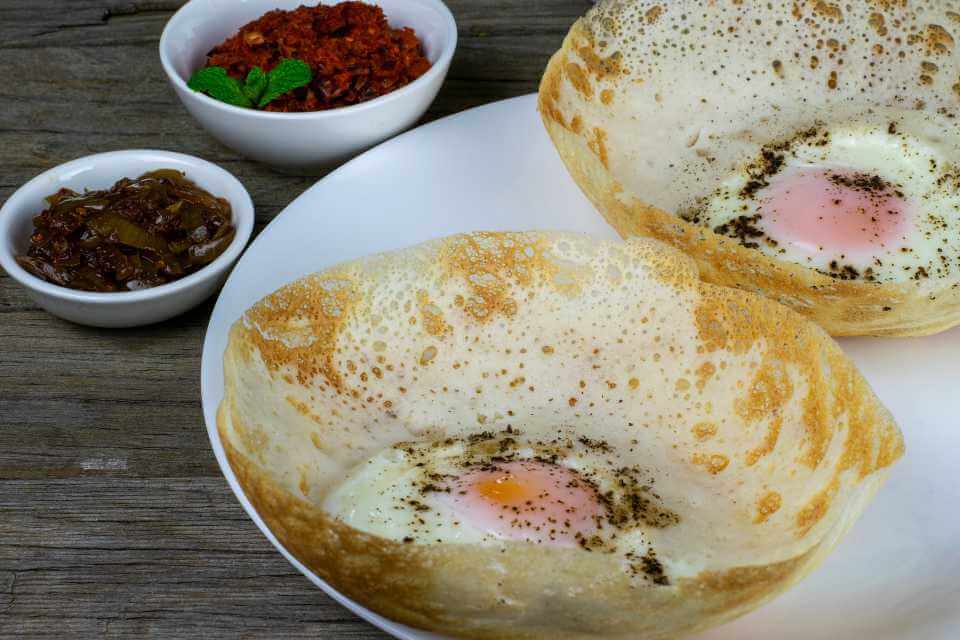Food and Drinks
Sri Lankan cuisine reflects the multi-cultural influences that have influenced the island country in the past and in the present. However, the dish retains a unique flavor. From conventional rice and curries to string hoppers, hoppers, roti, and thosai, there is plenty to tempt your taste buds. Biriyani allows you to interact with Moorish traders, whilst love cake and lamprais put you into contact with Sri Lanka’s colonial overlords. Ultimately, anything you consume will keep you going back for more.
Cuisine Sri Lanka
Curry and rice
Rice and curry is the national dish of Sri Lanka, and it can be eaten no matter where you stay in the country. A plate of rice provided by your host or yourself might be accompanied with a variety of side dishes, such as vegetables, eggs, meat, or fish cooked with peppers, spices, and, in many cases, coconut milk. Aside from rice, most typical meals consist of the omnipresent curries and a starchy staple ranging from String Hoppers (rice or wheat flour noodles), Hoppers (cup-shaped rice flour pancakes), Roti (a flat bread made of wheat and shredded coconut), to Thosai (a sourdough pancake). Sambol, a distinctive side dish, will undoubtedly be there.
Sambol will tease your mouth with its somewhat fiery peppery flavor whether you stay in a Sri Lanka Resort or a Sri Lanka Holiday Bungalow in the forest. It’s created with scraped coconut, a pinch of salt, and lots of red pepper. It is sometimes finely mashed into a paste, which is an useful arrangement if you consume it with bread. Aside from the main foods mentioned above, Sri Lankan cuisine is a massive amalgamation of influences from our South Indian neighbors, Arab and Moorish traders, and Portuguese and Dutch immigrants. The English impact, on the other hand, is little.
Biriyani
Biriyani is related to the Spanish cuisine paella as well as the Italian dish risotto. It is rice cooked in stock with other seasonings to improve the flavor of the rice. Biriyani has a unique aroma; when cooked, it emits a smell that can be detected from a distance. It is one of the most delectable rice recipes in Sri Lanka. To improve the flavor, spices, stock, ghee, and vegetables or meat are added to the rice. The beauty of biriyani stems from the method of cooking rice in stock alongside the meat and veggies in the same pot, enabling the flavors to permeate the rice as it cooks.
Biriyani can be made more appealing by adding currants, mustard seeds, or coriander leaves, as well as meat such as chicken, mutton, beef, or even prawns.
There’s also ‘Lamprais,’ a Sri Lankan dish made of yellow rice cooked with turmeric, coconut milk, and spices, topped with an onion sambol and plenty of Maldives fish chips. Brinjal Moju, a pickled salad, is another option. It is grouped together.
with a cooked egg slightly tempered with a huge slice of chicken or mutton breast wrapped in a tidy square packet of banana leaf, which accentuates the flavor Pittu arrived in Sri Lanka with the Malay troops brought in by the Dutch and English, and it is now a traditional main dish in Sri Lankan cuisine. Pittu is a steamed in a bamboo mould mixture of fresh rice meal that has been mildly toasted and combined with fresh, shredded coconut.
Thosai
Thosai, a traditional Tamil dish, is a favorite of all Sri Lankans. It also happens to be both tasty and healthful. This lentil pancake is made with rice flour and Urad dhal and cooked with sesame oil. Thosai is a tortilla-like dish that is served with finely ground coconut and chile sambol. The Vadai, little savory rissoles of ground red dhal, is the essence of Tamil cuisine and the traditional complement for thosai. At least once a week, most Sri Lanka Beach hotels and hotels in Sri Lanka serve these foods at buffets. No trip to Sri Lanka would be complete until you tried these foods at least once!
Sweets
Watalappam is a delectable baked custard prepared with jaggery, eggs, and coconut milk, as well as cardamom and cloves. The thin golden brown layer on top is a treat in and of itself. Buffalo Curd with Treacle is the most prevalent and recurring desert of the country’s affluent, poor, and middle classes equally. Traditional jaggery is manufactured from the Kitul palm tree and is unrefined. It is not industrially processed and so difficult to obtain. Jaggery manufactured from the coconut palm is widely accessible and a good replacement, although it does not taste the same as that prepared from the Kitul palm tree. The treacle served with curd is made from both the uncommon Kitul palm and the Coconut palm.




